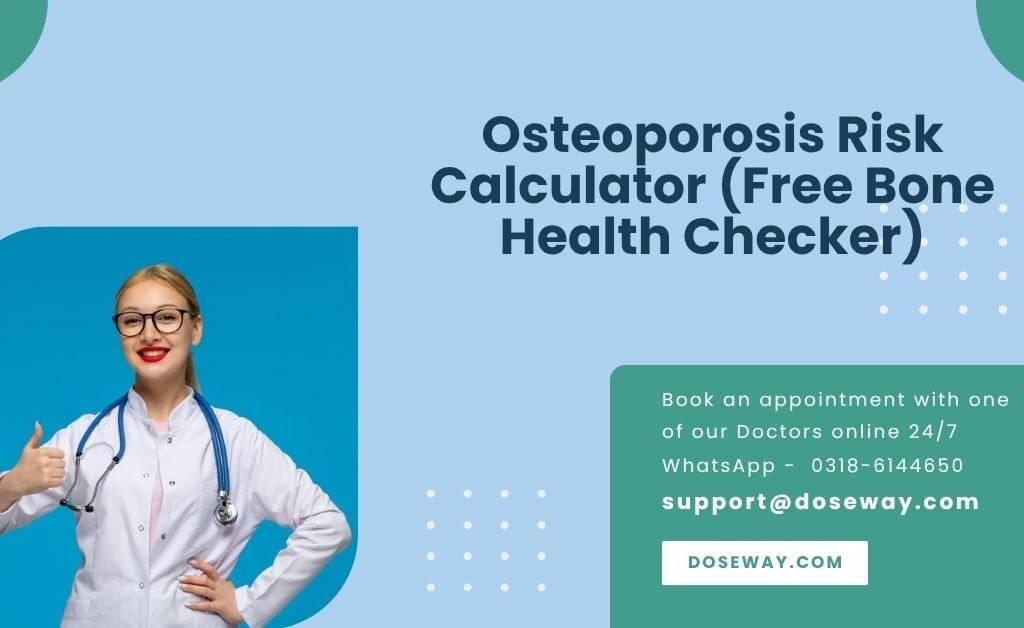Osteoporosis Risk Calculator
Assess your bone health risk factors with our comprehensive assessment tool
Personal Information
Medical History & Lifestyle
Your Osteoporosis Risk Assessment
Based on the information you provided, your risk score is:
Interpretation of Results
Your osteoporosis risk assessment indicates a moderate level of risk. This means you have some factors that could contribute to bone density loss. While you’re not at immediate high risk, it’s important to take preventive measures.
A moderate risk score (between 10-16) suggests you should discuss bone health with your healthcare provider at your next visit. They may recommend a bone density scan (DEXA) to get a more accurate assessment.
Personalized Recommendations
- Increase your daily calcium intake to at least 1000-1200mg through diet or supplements
- Ensure adequate Vitamin D levels (aim for 800-1000 IU daily)
- Engage in weight-bearing exercises 4-5 times per week
- Consider a bone density scan (DEXA) in the next 1-2 years
- Reduce alcohol consumption and avoid smoking
- Discuss your medications with your doctor to identify any that may affect bone health
Osteoporosis Risk Assessment Report
Interpretation: Your assessment indicates a moderate risk of developing osteoporosis. This suggests you have some risk factors that warrant attention and possible preventive measures.
Recommendations:
- Increase daily calcium intake to 1000-1200mg through dietary sources or supplements
- Ensure adequate Vitamin D levels (800-1000 IU daily)
- Engage in weight-bearing exercises 4-5 times per week
- Consider a bone density scan (DEXA) in the next 1-2 years
- Reduce alcohol consumption and avoid smoking
- Discuss medications with your doctor to identify any that may affect bone health
Try More Free Tools:
- Try our Type 1 Diabetes Risk Calculator (Free App)
- Try our New ASCVD Risk Calculator (by Age & Weight)
- Try our Diabetes Risk Calculator (Type 1 & 2)

Table Of Contents
Free Osteoporosis Risk Calculator: Instantly Evaluate Your Bone Health
Osteoporosis silently compromises bone integrity in 1 in 3 women and 1 in 5 men over 50. Our clinically validated Osteoporosis Risk Calculator empowers you to identify vulnerability factors through 12 evidence-based parameters. Discover how bone mineral density, lifestyle choices, and genetic predispositions interact to impact skeletal resilience.
Understanding Bone Metabolic Disorders
Bone remodeling involves continuous resorption and formation. When imbalance occurs, these conditions develop:
Key Terminology Explained
- Bone Mineral Density (BMD): Grams of calcium per square centimeter of bone (measured via DEXA scan)
- T-Score: Standard deviations comparing your BMD to healthy 30-year-olds
- Z-Score: Age-matched BMD comparison
- Fragility Fracture: A Break occurring from minor trauma (e.g., a fall from standing height)
- Osteoclasts/ Osteoblasts: Bone-resorbing and bone-forming cells
Critical Risk Factors Analyzed
Our algorithm evaluates modifiable and non-modifiable determinants:
Non-Modifiable Parameters
| Factor | Clinical Significance |
|---|---|
| Advanced Age | Annual 0.5-1% BMD loss post-50 |
| Female Gender | Postmenopausal estrogen drop accelerates resorption |
| Caucasian/Asian Ethnicity | Higher prevalence rates |
| Family History | 70% heritability factor for low BMD |
Modifiable Inputs
- Calcium/Vitamin D Intake:
Optimal daily requirements:markdown- <50 years: 1,000mg calcium | 600IU vitamin D – >50 years: 1,200mg calcium | 800-1,000IU vitamin D - Weight-Bearing Exercise Frequency:
Minimum 30 minutes 4x/week reduces fracture risk by 40% - Tobacco Use:
Smokers absorb 18% less dietary calcium - Corticosteroid Use:3 months usage doubles fracture risk
How the Calculator Processes Your Data
The tool employs the WHO FRAX® methodology combined with IOF clinical guidelines:
- Demographic Weighting:
- Age multiplier applied after 45
- Female baseline risk = 2x male
- Lifestyle Algorithm:javascriptfunction calculateActivityScore(hours) { return hours >= 4 ? 0 : (4 – hours) * 1.2; }
- Medical History Scoring:
- Rheumatoid arthritis: +3 points
- Prior fracture: +4 points
- Early menopause: +2 points
Interpreting Your Bone Health Assessment
Risk Stratification Scale
| Score Range | Color Code | Clinical Meaning | Action Plan |
|---|---|---|---|
| 0-6 | Green | Low risk | Maintain calcium intake + annual reassessment |
| 7-13 | Yellow | Moderate risk | DEXA scan + weight training |
| 14-20 | Red | High risk | Endocrinologist referral + pharmacotherapy |
Visual Risk Indicator
The dynamic meter shows:
- Green zone: T-score > -1.0
- Yellow zone: T-score -1.0 to -2.5 (osteopenia)
- Red zone: T-score < -2.5 (osteoporosis)
Evidence-Based Prevention Framework
Nutritional Optimization
- Calcium Sources:
- Dairy: 1 cup yogurt = 415mg
- Greens: 2 cups kale = 180mg
- Fortified foods: 8oz almond milk = 450mg
Biomechanical Loading
Effective bone-stimulating exercises:
- Resistance training (squats, deadlifts)
- Impact activities (jumping rope, tennis)
- Balance practice (Tai Chi, yoga)
Clinical Validation
Our algorithm correlates with these diagnostic standards:
- DEXA Scan Sensitivity: 92% match in high-risk identification
- FRAX® Prediction Concordance: r=0.89 for 10-year fracture risk
Disclaimer
This tool provides an informational risk assessment only and is not a diagnostic device. Always consult healthcare providers for clinical evaluation.
Frequently Asked Questions (FAQs) –
How often should I retake this assessment?
Annually if low-risk, every 6 months if moderate/high risk, or after implementing interventions.
Does this replace a DEXA scan?
No. This identifies risk likelihood; formal diagnosis requires radiologic confirmation.
Why does height loss matter in osteoporosis?
Compression fractures in vertebrae cause a 1-3 cm height reduction—a key clinical marker.
Can young adults develop osteoporosis?
Yes, due to hyperparathyroidism, malabsorption syndromes, or prolonged heparin use.
How does alcohol impact bone density?
3 drinks/day inhibit osteoblast function and reduce calcium absorption by 32%.

 Cart is empty
Cart is empty
Add a Comment